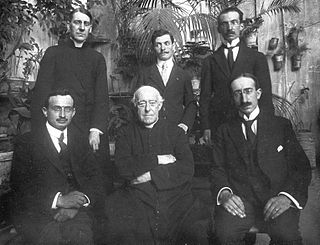
Jean Leclant was a renowned Egyptologist who was an Honorary Professor at the College of France, Permanent Secretary of the Academy of Inscriptions and Letters of the Institut de France, and Honorary Secretary of the International Association of Egyptologists.
Robert Flacelière was a scholar of Classical Greek. He was educated at the Collège Sainte-Barbe, the Lycée Henri IV and the École Normale Supérieure. From 1925 to 1930, he was a member of the French School in Athens and from 1932-1948 a Professor of the Faculty of Letters at University of Lyon. He was then appointed to the Chair of Greek Language and Literature at the University of Paris, a post he held until 1963 when he was appointed Director of the École Normale Supérieure.
Pierre Grimal was a French historian, classicist and Latinist. Fascinated by the Greek and Roman civilizations, he did much to promote the cultural inheritance of the classical world, both among specialists and the general public.
Professor Jean Pouilloux was a French hellenist archaeologist.
Noël Duval was a French archaeologist.
Francis Croissant was a French archaeologist and art historian specializing in Archaic Greece, especially sculpture.
Roland Martin was a French archaeologist.

Maurice Holleaux was a 19th–20th-century French historian, archaeologist and epigrapher, a specialist of Ancient Greece.
Ernest Louis Georges Will was a 20th-century French archaeologist and University professor, a member of the Académie des Inscriptions et Belles-Lettres.
Cécile Michel is a French epigrapher and archaeologist.
William Seston was a 20th-century French historian and epigrapher, a specialist of the history of the Roman Empire. He was professor at the Sorbonne and a member of the Académie des Inscriptions et Belles-Lettres.
Jean-Louis Ferrary was a French historian, a specialist in ancient Rome.
Robert Schilling was a 20th-century French historian and Latinist, a specialist in the history of religion in ancient Rome.
Jacques Heurgon was a French university, normalian, Etruscan scholar and Latinist, professor of Latin language and literature at the Sorbonne. Married to Anne Heurgon-Desjardins, founder in 1952, of the Centre culturel international de Cerisy-la-Salle, he was the father of Marc Heurgon, politician and historian, Catherine Peyrou and Edith Heurgon who continued the "Colloques of Cerisy".

Jean Bayet was a French Latinist. A Professor of Latin Language and Literature at the Sorbonne, he was Director-General of Education in 1944 and Director of the École française de Rome from 1952 to 1960. In 1948 he was elected a member of the Académie des inscriptions et belles-lettres. A specialist of Latin literature and Religion in ancient Rome, Jean Bayet, through his works and the theses he directed, played a decisive role in the development of a French school of history of the Roman religion, particularly active in the second half of the twentieth century.
Jeanne Robert was a French ancient historian and epigrapher, and co-author and editor of many volumes on Greek epigraphy.
Pierre Chuvin was a French hellenist and historian. He was specialized on ancient Greece and Greek mythology, as well as modern Central Asia and the Turkic-speaking world.

The Neirab steles are two 8th-century BC steles with Aramaic inscriptions found in 1891 in Al-Nayrab near Aleppo, Syria. They are currently in the Louvre. They were discovered in 1891 and acquired by Charles Simon Clermont-Ganneau for the Louvre on behalf of the Commission of the Corpus Inscriptionum Semiticarum. The steles are made of black basalt, and the inscriptions note that they were funerary steles.
Leïla Ladjimi-Sebaï is a historian, archaeologist and epigrapher, writer and poet from Tunisia. She is a specialist in the history of Roman-era women in North Africa and the history of Carthage.
Luce Pietri is a French historian and scholar of late antiquity.




